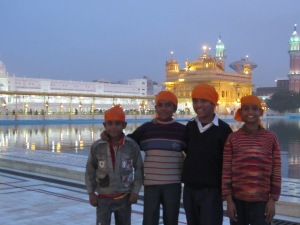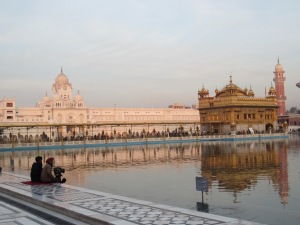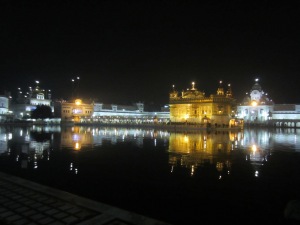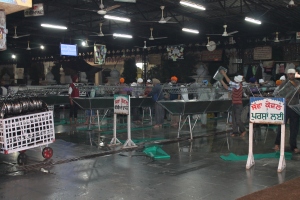Feeding the Masses
Leave a commentJanuary 28, 2013 by Louis Ritzinger
Its been another week of traveling through the subcontinent (or at least the northern portions of it) for me, although I suspect that it will be the last extended trip I make for some time, what with my internship formally beginning tomorrow and all. I’m also anxious to begin my Urdu tutoring this week. The level I’m at now is fine for moving around the city, ordering food, getting directions, and basic conversations, but I’m finding a real level of comprehension to be elusive. This unfortunate fact pops up to bite me at least several times a week. Frequently its in the form of the irritated paan (essentially Indian chewing tobacco) muffled yellings of a rickshaw driver. Other times its the casual chit-chat with a friendly stranger, who unknowingly veers away from the confines of well-rehearsed small talk, leaving me to repeat his words in the hopes of cobbling together some meaning – which does occasionally happen, although often too long after the fact. There’s nothing worse, however, than the self-conscious embarrassment of knowing you are being talked about right in front of your face, and yet not having the words to respond. It is a relatively rare occurrence, but still I feel that far too often I am left standing with a puzzled look on my face, trying to piece together what is being said about me and what I can do about it. I have to believe it is no coincidence that these instances tend to involve the exchange of money.
It turns out that not wanting to feel like an idiot is pretty good motivation to learn a language.
My girlfriend, Rachel, arrived in India last week after completing a Winter Break course in Cambodia. After spending a few days exploring a little of Delhi, as well as a few dates to some excellent restaurants to sample some of the local cuisine, the plan was to catch a train on Monday for Amritsar before flying to Lucknow so that Rachel could see where I had been living for the past few months and meet some of my friends there. I also thought it might be nice to show her around a city I actually knew somewhat well, as I’m very much still adjusting to the Delhi scene. However things, as they tend to do here, didn’t quite go according to plan, and as much as I would like to blame India (always a very convenient scapegoat), this one was pretty much 100% my fault.
It all started somewhere underneath the streets of New Delhi. In the metro, to be precise. Somewhere on the yellow line, to be more precise. There Rachel and I stood in a packed subway car, our backpacks placed on the ground in front of us, a train ticket in Rachel’s purse, bound for the New Delhi railway station. We were making good time, looking forward to a relaxing train ride through the North Indian countryside to the border city of Amritsar, home of Sikhism’s most holy site – the magnificent Golden Temple. It was a trip I had wanted to take for several years, and now we were on our way. Things were looking up. As I often do before going on trips, I ran through a mental checklist of the essentials.
Train ticket: check
Plane tickets: check
Map to the hotel: check
Passport: che- oh no. Oooooooh no.
“Rachel.” I said, panicking. “The passport.”
“I have mine!” She said confidently, as if to calm my nerves.
“No. I mean mine. I forgot my passport.”
Rachel gave me a look that somehow conveyed both deep sympathy and profound irritation. Girls can do those things, you know.
I then said a whole bunch of things that don’t need to be rewritten here.
“Maybe you don’t need it?” Rachel said in a hopeful tone.
“No. We’ll need it for the plane. I’m not traveling without my passport.”
The truth was that I wasn’t completely sure if I would need it or not, but the image of us trying to board the plane in Amritsar and being denied entry because I lacked a passport was scary enough to make me not want to take the chance. In the meantime, with each passing stop we got closer and closer to the Railway Station and farther away from my apartment, where my passport sat in a drawer in my room. I tried to call my housemate with the hope that he could do me the enormous favor of driving my passport for the station. No answer.
“We’ll have to get out at the next stop and try and get a rickshaw back,” I said, glancing at my watch. We had 40 minutes. It would be least a 30 minute ride from my apartment back to the station. “We’ll never make it.”
“Let’s at least try,” Rachel replied, always the optimist.
We sprinted out of the station toward an autorickshaw parked against the sidewalk. Exasperated, I explained to him, as quickly as I could in Hindi, that I had forgotten my passport at my apartment in Saket, and that we had a train to catch in 40 minutes.
He looked at his watch. Then back at me like I was nuts.
“Please just try!” I yelled, throwing our bags in the back seat and climbing in after them.
About five minutes away from our apartment, and ten minutes before our train was to leave, my housemate, Lavy, called me back. Feeling completely defeated, I explained the situation to him.
“Louis,” he said to me, groaning as if my idiocy was causing him physical pain, “you don’t need a passport to travel within India. By law, any form of photo ID is valid. My old tenant had the same situation, and he was from out of the country as well.”
I was silent.
“Oooooh….” he trailed off. “So sad.”
We made it back to our apartment five minutes before our train was to leave. At this point, with Rachel’s help, I had calmed down a substantial bit. We thanked the driver for his efforts and made our way slowly up the stairs to the third (or second, here in India) floor.
Lavy, at this point, went well beyond the call of duty and attempted to get us last-minute tickets through a travel agent that he knew, to no avail. We then made our way back to the station with all of our bags to wait in line to see if any additional tickets would be released before the train left, as occasionally happens if enough people cancel their reservations. Again, no luck. I called Lavy to see if his friend could get us tickets for a train on the following morning. Finally, some luck: two tickets on the 6:40am train to Amritsar. We took the opportunity for another date night in Delhi.
Aside from being erroneously told by multiple sources upon our arrival at the station at 6:15 the next morning that our train had been canceled, and almost taking a cab to the “tourist office” a mile down the road (in what was, in hindsight, a blatant scam), things went relatively well the next day. We boarded our train – a dingy coach, outfitted with mismatched tray-tables held against the seats in front of us with twisted shards of sharp metal, loosely screwed in to replace the original latches that a few of the other seats had managed to maintain. A British woman a few rows up from us spent a good 40 minutes loudly asking every one of the vendors, who walk up and down the train not only displaying, but announcing their wares of sandwiches, chips, sodas, and juices, if he was the “chai guy.”
To everyone’s relief, the “chai guy” did eventually appear, right in the nick of time.
The thing about India, though, is that for every one of those teeth grinding, insanity inducing, wall punching, blood vessel bursting experiences that make you want to just let out a string of curses at the top of your lungs, throw every Bollywood movie ever made into a giant blender filled with gasoline and book the first plane back to New York, there are places like the Golden Temple.
After we got off the train in Amritsar (which, to be fair, wasn’t as bad as the above description might imply, once the lady finally got her chai and we could all sleep) and checked into our hotel, we took a 15 minute cycle rickshaw ride through the old city, arriving just outside the Golden Temple, whose pristine white interior archways, elegant domed clock towers, and golden-crowned Akal Takht (thhe center of Sikh temporal governance) could be glimpsed through gold, green, and purple tinsel streamers that hung over the dusty brick approach. I purchased a small orange handkerchief for 10 rupees (both men and women must cover their heads in any Sikh Gurudwara) from a vendor outside, and Rachel and I followed the signs to the shoe stall, where our shoes and socks would be stored free of charge (actually pretty rare around here).
Rachel and I slowly made our way along the cool, strikingly clean, white marble pathway and through the small stream of water meant to cleanse the feet of all who enter. The Golden Temple itself, appears to be a splendid palace cast in miniature, delicately placed atop a pool of crystal clear (yes, really) water – Amrit, or “immortal nectar,” from which the city gets its name. Koi drift lazily beneath the surface, forming bunches beneath children who lean out over the water, giggling at the fish’s gaping O-shaped mouths, grasping at the air in anticipation of food. A carpeted footbridge leads pilgrims to the Temple’s entrance, manned by two men holding a long pole between them and across the path. The pole is raised when there is enough space in the temple for people to enter, and lowered when there is not – a surprisingly effective method of crowd control given the pushing and straining that is the norm around here when many people seek to occupy a limited space.
Let me preface this by saying that I have been to a number of different religious services and sites of several different denominations. I’ve been to Catholic, Anglican, and Pentecostal Churches, Sikh Gurudwaras, a number of Hindu Temples, and Mosques of both Sunni and Shi’a branches. But no matter how many times I go, there is always a certain uneasiness I feel, particularly when my presence and status as an outsider are conspicuous (and as a young white couple with cameras, one of whom wearing one of the orange head coverings clearly purchased just outside the Temple walls, our conspicuousness was undeniable). There’s a certain tension in these types of situations that I can’t help but feel. Moments of religious devotion are, by their nature, highly intimate, and the emotional and, indeed, often physical divide between observer and observed can be a difficult one to broach – yet it is undeniable. I certainly expected it to be present amidst a community as often misunderstood and maligned as the Sikhs.

Some kids asked us to take their picture
Yes, the Temple is stunning – truly breathtaking. We sat along the water’s edge as the setting sun cast its last orange hues across the placid, clear pool, and off the Temple’s brilliant golden exterior. The gentle hum of the harmoniums drifted through the air, rising and falling around the tabla’s high hollow pitter patter and deep bass thump. We walked across the footbridge to the Temple itself – a few times, in fact – entering the warm, peaceful sanctuary of the Guru Granth Sahib, Sikhism’s holy book, first compiled by Guru Arjan Dev, the fifth spiritual leader of the Sikh community, and affirmed by Guru Gobind Singh, the tenth, as his permanent, living, successor. There it lay, elevated on red, velvet cushions, surrounded on either side by small gatherings of male and female devotees who sat beneath it, on the ground. An elderly priest gently fanned the book while another stared intently at its enormous pages, silently reciting its words. The music we had heard, to my amazement, was being flawlessly played by three musicians who sat to our left. We stayed at the Temple for six hours, and only briefly did they pause.
More devotees sat above us, their eyes peering down at the tranquil scene below through the splendid marble carvings that supported the second story railing. As we exited I noticed two sets of stairs leading upwards but, not wanting my presence in a private area to inadvertently offend, kept walking.
As I said, the Golden Temple in itself is truly a work of art. What makes it a truly wonderful, peaceful place, however, is the graciousness with which its congregants treat all comers. Rachel and I were free to wander as we pleased for as long as we pleased, and men and women alike greeted us with warm, genuine kindness. I felt that boundary, that anxiety I have so often felt in places like this disappear, replaced with a calm serenity – a feeling of belonging. As we crossed back over the footbridge an older gentleman inquired as to where we were from, and welcomed us to Amritsar.
“Did you walk up the stairs to the roof of the temple?” He asked.
“No…” I trailed off. “I wasn’t sure if I could.”
“Oh you must! Please do!” He quickly replied, smiling.
We turned back around, walked slowly back through the warmth of the Temple, and walked up the stairs to the second floor. There men and women sat, some with eyes closed, others reading from books made freely available on a shelf in the middle of the room. Rachel and I took a seat near one of the windows for some time, then walked slowly around the periphery from where we had earlier seen people looking below. We took another flight of stairs up to the roof, taking in the night scene around us.
At this point both of us were feeling quite hungry, so we walked just outside of the Temple to its free kitchen – an astounding all-volunteer operation that feeds as many as 60,000 people a day. We walked in, were handed a metal place, bowl, and spoon, and ushered to an enormous room with about a dozen rows of carpet running lengthwise across it. We then sat on the ground, surrounded by others, as men walked along the rows, placing rotis, and pouring dal, rice, and sweet porridge onto each plate, one by one. When we had had our fill, we simply picked up our plate, walked out of the room, and returned it to another group of volunteers waiting outside. Dozens of others were engaged in the massive task of cleaning all of the utensils and plates before they were redistributed again to the steady stream of hungry mouths walking through the door. They scurried here and there: scraping, washing, and rinsing – laboring for us, the teeming masses.
We stayed until Ten o’clock, when the Guru Granth Sahib was ceremoniously removed from the Temple itself on a canopied bed of fresh, perfumed linens, draped with fresh flower garlands, and placed in the Akal Takht, its nighttime resting place. A calm descended on the small crowd as we donned our shoes once again (a welcome relief to our chilly toes) and made our way back out into the night.
As we walked back toward the Old City, quiet of the night was only periodically broken by the sharp clang of metal from the team of volunteers, working away in the kitchen. There were still more mouths to feed.



